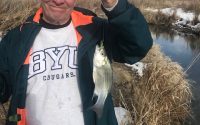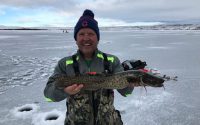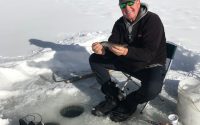Blind Fishing — The Woes Of An Angler Without a Fish Finder
I just realized that most anglers don’t use their fish finders for more than just a fancy depth finder. It’s difficult for me to believe that anglers are forced to fish “blind” rather than figuring out how to make their electronics into fish catching machines. Let me tell you pieces of a recent story that should peak some interest in this subject.
On a recent trip to Lake Powell after wintertime striped bass (stripers) I was fishing from the back of my best friend’s new bass boat. He had two fish finders on the deck but the one on the console closest to where I was standing continually lost the bottom signal. To put it bluntly, if your fish finder won’t show you the bottom 99 percent of the time — either fix it or throw it away!
There are several adjustments that could help you find the bottom should your machine simply be maladjusted.
- Check your automatic versus manual menu choices, specifically, “range” or “Chart Speed”. Start by turning automatic back on. This will reset your bottom range and should help you find it. Chart speed should also be on automatic but you might experiment by slowing it down manually and see if that also doesn’t help you find the bottom.
- Next, check your frequency. Most units run at 200 khz and most transducers have at least one other setting. Mine has three, 200, 83, and 40 khz. Try changing the frequency down to lower khz to see it that might also work.
- Next, while your boat is dry, turn on your finder, locate the transducer and physically listen to the sounds it makes. My Lowrance transducers make a clicking sound. If you don’t hear a sound from your transducer it might not be working. Check your connections and then look into replacing the transducer. You can find them online and I always find that OEM products are much better sources than E-bay.
Now, back to the story. We found stripers schooled in 50 to 70 feet of water in the backs of several canyons north of Bullfrog Marina. However, fishing blind I couldn’t figure out how high off the bottom I needed to drop my spoon. My Friend, Brent, tried to assist but he was busy running his trolling motor and really didn’t communicate well with me. When my finder finally began working about half of the time, I immediately began to catch fish because they were literally waiting for my spoon to stop and be jigged right in front of their noses.
When anglers struggle to catch stipers it is because of two or three reasons:
- They don’t know where to find them.
- They don’t know their depth
- They don’t know which baits to use
I know this sounds incredibly simple, but it’s true. Here is a solution to this problem.
Get your fish finder working and you will solve two of the three problems with catching stripers. Once your fish finder shows the bottom, then turn your “sensitivity” setting on automatic and look for fish on your screen either on the bottom or in a tight school suspended in around 50 feet of water in the winter and a little more shallow in spring and summer. Stripers look like pieces of firewood carefully stacked in a pile. Once you recognize the school just drop a shad-colored spoon through the school and jig up and down. You should be able to watch your spoon drop under the surface and down to the school on the screen of your fish finder. If the fish won’t respond to a spoon, simply put a piece of anchovy on a weighted hook and drop down to the school. This is really how simple it is to catch stripers at Lake Powell.
With you fish finder on, just move through the middle or trough of a bay for canyon looking for fish on your screen. When you find the stripers just stay on top of the school and drop straight down to them. I promise you will learn to target and find fish and you can actually catch! When you begin to use your fish finder to actually locate fish you will join the world of sight and you will never want to return to fishing blind.











Don, I couldn’t agree more about fishermen not understanding how to use their electronics. People will spend $1000 or more on a Side Imaging unit and never learn how it works. It’s unbelievable really, which is why I wrote a tutorial on it.
Luke Thomas recently posted..Side Imaging Tutorial (Plus Tips and Tricks)